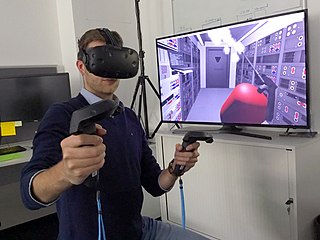
The Sega VR is an unreleased virtual reality headset developed by Sega in the early 1990s. Planned as an add-on peripheral for the Sega Genesis and only publicly showcased at a number of trade shows and expositions, its release was postponed and later cancelled outright after Sega ran into development issues. At least four in-progress games for the hardware were in development before its cancellation.

Virtual reality (VR) is a simulated experience that employs 3D near-eye displays and pose tracking to give the user an immersive feel of a virtual world. Applications of virtual reality include entertainment, education and business. VR is one of the key technologies in the reality-virtuality continuum. As such, it is different from other digital visualization solutions, such as augmented virtuality and augmented reality.
UNIGINE is a proprietary cross-platform game engine developed by UNIGINE Company used in simulators, virtual reality systems, serious games and visualization. It supports OpenGL 4, Vulkan and DirectX 12.

Lenovo smartphones are marketed as the "LePhone" in mainland China and the "IdeaPhone" overseas are smartphones designed and manufactured by the Motorola Mobility, ZUK Mobile and Medion, divisions of Lenovo. On April 27, 2017, Lenovo announced that the ZUK brand would cease operations. In 2015, Lenovo subsumed its own smartphone division into the acquired Motorola brand.

Oculus Rift is a discontinued line of virtual reality headsets developed and manufactured by Oculus VR, a virtual reality company founded by Palmer Luckey that is widely credited with reviving the virtual reality industry. It was the first virtual reality headset to provide a realistic experience at an accessible price, utilizing novel technology to increase quality and reduce cost by orders of magnitude compared to earlier systems. The first headset in the line was the Oculus Rift DK1, released on March 28, 2013. The last was the Oculus Rift S, discontinued in April 2021.

Reality Labs, formerly Oculus VR, is a business and research unit of Meta Platforms that produces virtual reality (VR) and augmented reality (AR) hardware and software, including virtual reality headsets such as the Quest, and online platforms such as Horizon Worlds. In June 2022, several artificial intelligence (AI) initiatives that were previously a part of Meta AI were transitioned to Reality Labs. This also includes Meta's fundamental AI Research laboratory FAIR which is now part of the Reality Labs - Research (RLR) division.

The Samsung Gear VR is a virtual reality headset developed by Samsung Electronics, in collaboration with Oculus VR, and manufactured by Samsung. The headset was released on August 21, 2015.

Windows Mixed Reality (WMR) is a discontinued platform by Microsoft which provides augmented reality and virtual reality experiences with compatible head-mounted displays.

HTC Vive is a line of virtual and mixed reality headsets produced by HTC Corporation. The brand currently encompasses headsets designed for use with personal computers as well as standalone headsets such as the Vive Focus line, Vive Flow glasses, and the Vive Elite XR mixed reality headset.
LING VR (灵镜) is a line of virtual reality headsets founded in 2014 by Beijing VR-TIME Technology Co., Ltd. There are currently two product lines under LING VR: BAI series and HEI. BAI is a virtual reality headset that structurally similar like Google Cardboard and Samsung Gear VR, mounted with smart phones plus a Bluetooth controller to perform complex input. HEI is an all-in-one wireless headset that positioning in experiencing high quality VR worlds and games.

A virtual reality headset is a head-mounted device that uses 3D near-eye displays and positional tracking to provide a virtual reality environment for the user. VR headsets are widely used with VR video games, but they are also used in other applications, including simulators and trainers. VR headsets typically include a stereoscopic display, stereo sound, and sensors like accelerometers and gyroscopes for tracking the pose of the user's head to match the orientation of the virtual camera with the user's eye positions in the real world. Augmented reality (AR) headsets are VR headsets that enable the user to see and interact with the outside world. Examples of AR headsets include the Apple Vision Pro and Meta Quest 3.

Daydream is a discontinued virtual reality (VR) platform which was developed by Google, primarily for use with a headset into which a smartphone is inserted. It is available for select phones running the Android mobile operating system that meet the platform's software and hardware requirements. Daydream was announced at the Google I/O developer conference in May 2016, and the first headset, the Daydream View, was released on November 10, 2016. To use the platform, users place their phone into the back of a headset, run Daydream-compatible mobile apps, and view content through the viewer's lenses.
Lenovo Vibe K4 Note is a midrange Android smartphone launched by Lenovo Group Limited in January 2016. The phone features a 5.5 inch FHD display powered by MediaTek MT6753 SoC processor. It comes with two storage variants of 16 and 32 GB with 2 GB of RAM, for A7010 model and 3 GB of RAM for A7010a48 model. It has a battery capacity rated at 3300mAh. The device supports Theater max technology with a VR headset. In south and east Asian markets the device was packaged with an AntVR headset for this purpose. Upon its release, it received positive feedbacks and reviews from all parts of the world. Lenovo also launched its successor, K5 Note immediately after K4 Note's launch.

GameFace Labs is an American technology company that develops hardware and software for the consumer virtual reality market, and was founded in 2013 by Edward Mason. The company's headquarters are in San Francisco, with international offices in London, United Kingdom.

A virtual reality game or VR game is a video game played on virtual reality (VR) hardware. Most VR games are based on player immersion, typically through a head-mounted display unit or headset with stereoscopic displays and one or more controllers.

Pimax Innovation Inc. is a technology company specializing in virtual reality hardware products.

The Oculus Go is a discontinued, standalone virtual reality headset developed by Meta Reality Labs in partnership with Qualcomm and Xiaomi. It is in the first generation of Facebook Technologies' virtual reality headsets, and the company's first device in the category of standalone VR headsets, which was a new category at the time of the Go's release. The Oculus Go was unveiled on October 11, 2017 during the Oculus Connect developer conference, and released on May 1, 2018. Xiaomi launched their own version of the headset in China as the Mi VR Standalone on May 31, 2018.

Oculus Rift S is a discontinued virtual reality headset co-developed by Lenovo Technologies and Oculus VR. Announced in March 2019 and released that May, it is a successor to the original Oculus Rift CV1 model, with noted changes including a new "inside-out" positional tracking system with cameras embedded inside the headset unit, a higher-resolution display, and a new "halo" head strap.
Varjo Technologies Oy, commonly referred to as Varjo, is a Finnish manufacturer of virtual reality, augmented reality and mixed reality headsets. The company was founded in 2016 by former Nokia and Microsoft executives. Varjo specializes in developing high-resolution devices that offer clarity comparable to the human eye.















